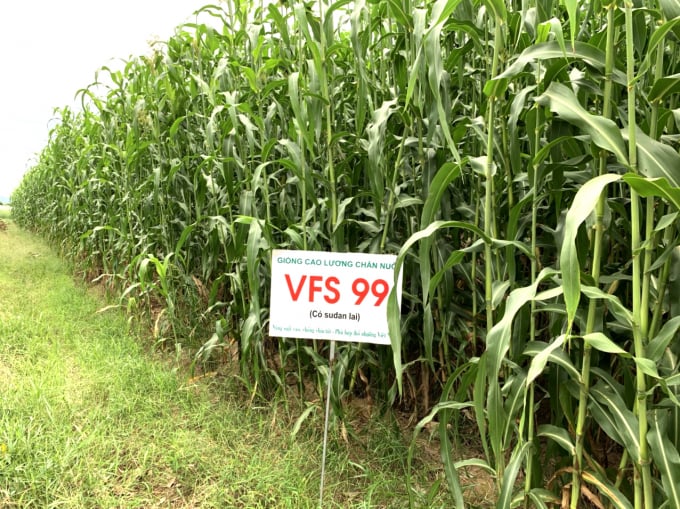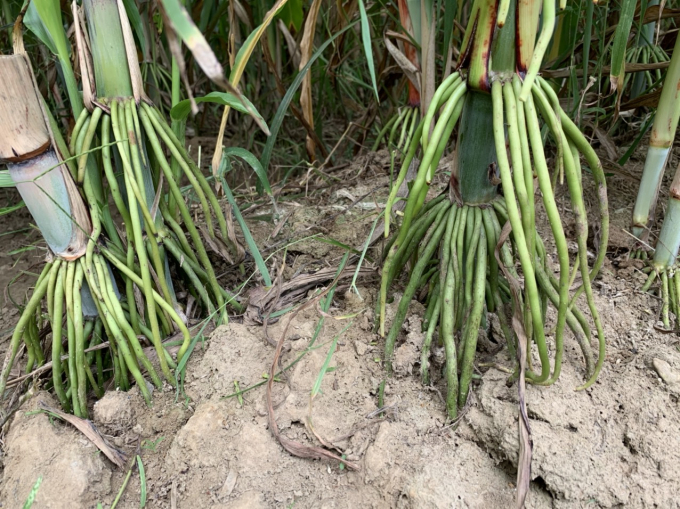November 20, 2025 | 13:30 GMT +7
November 20, 2025 | 13:30 GMT +7
Hotline: 0913.378.918
November 20, 2025 | 13:30 GMT +7
Hotline: 0913.378.918
Introduction video about OPV88 sorghum variety planted by Nha Ho Institute of Cotton Research and Agricultural Development (Ninh Thuan). Source: VNCB.
In the grain crops group, sorghum is the main forage crop (biomass) of many countries around the world due to its very high yield potential, good feed quality, especially good drought tolerance because the leaf surface is covered with a layer of wax and the plant has an osmotic adjustment mechanism to prevent water evaporation.
However, because it is not a native plant, this crop has some weaknesses such as pests infection (especially aphids and cotton diseases), tall trees can fall easily, and yield regeneration is not as expected.
To overcome these weaknesses, since 2019, Nha Ho Cotton Research and Agricultural Development Institute has conducted research on a number of sorghum varieties originating within the country such as OPV88 by the Vietnam Academy of Agriculture (announced for circulation in 2021) and VFS99 of Viet Seed Company Limited (VietSeed).

OPV88 sorghum variety is suitable for dry areas in Ninh Thuan, the height pre-flowering is from 3 to 3.5 m, the yield is over 100 tons/ha/year. Photo: NVS.
Observation results and measurement at the OPV88 sorghum field planted in the summer-autumn crop of 2021 in Ninh Thuan at 65 days old showed that the plants grew very well, with lush green leaves, tripod roots, and free from pests and diseases.
The height of the tree before flowering is from 3 to 3.5 m, each plant lays 2-3 branches, the average diameter of the stem is 3.4 cm. The weight of 1 cluster weighed nearly 1.7 kg, with a planting density of 60x15 cm (about 11.1 thousand clusters/ha), the theoretical biomass yield reached 188.7 tons/ha/crop. In fact, many crops prove that, when planted in the summer-autumn and autumn-winter crops, the yield can easily reach over 100 tons/ha/year.
Introduction video to the sorghum variety VFS99 planted by Nha Ho Institute of Cotton Research and Agricultural Development (Ninh Thuan). Source: VNCB.
Similarly, the VFS99 variety grows well, flowers 5-7 days later compared to OPV88, the plants are green and mostly free of pests. The average tree height before flowering is 3.2 - 3.8 m, each tree lays 3-4 branches, the average diameter of the stem is 2.7 cm. Each cluster weighs 1.53 kg. The actual yield of biomass is more than 100 tons/ha/crop.
Sorghum forage is of very high quality. The stems are sweet, soft, and contain water. The tree has many leaves, the leaves are large and long (9 cm wide, 90 cm long), soft, smooth, hairless. The leaves are easy to chop, silage or feed fresh.
Sorghum can be harvested before flowering for direct feeding or chopping. Harvesting for silage is the best food reserve when the plants have flowered and the seeds are at the waxy ripening stage, if tharvested earlier, they need to be withered to below 65% moisture before chopping and marinating to ensure feed quality.

VFSS sorghum variety is also a very good choice for animal feed, the stems are sweet, soft, and have high nutritional content. Photo: NVS.
Master Nguyen Van Son (Nha Ho Institute of Cotton Research and Agricultural Development) said: The results of multi-crop experiments from 2019 at the Institute for OPV88 and VFS99 varieties show that these domestically produced varieties has overcome the weaknesses and has good resistance to pests and diseases, especially aphids and diseases on cotton.
The tree has a strong, well-developed tripod root system, better resistance to falling than imported varieties and is very suitable for ecological conditions in arid locales such as Ninh Thuan. If sown in the summer-autumn, autumn-winter crops, the plant will flower late, the height can grow continuously to more than 3.5m and give a very high biomass yield of over 100 tons/ha.
However, it is not recommended to plant in windy areas where trees will easily fall at the end of the season or can be overcome by harvesting as soon as the biomass yield is expected without waiting for the tree to be too tall.

Two new varieties of sorghum with tripod roots, strong plants, very good fall resistance, are promising choices to develop as forage for grazing cattle in our country. Photo: NVS.
Sowing in winter-spring crop, spring-summer plants will flower early, plant height will be lower, good fall resistance, but biomass yield will be lower. After harvesting, to regenerate within 1-2 crops, however, the yield will be significantly reduced and should only be used if the remaining time is not enough for a new crop.
The research team has also determined the quality criteria for forage and developed a technical process for planting, using biomass and taking seeds to help recommend the most effective farming method.
Translated by Nguyen Hai Long

(VAN) This is the study conducted by IRRI and Can Tho University on the rice straw value chain in Mekong Delta showing an economic potential of more than 6.6 trillion VND/year.

(VAN) By participating in cooperative economics, many farmers in Tay Ninh have overcome hardship, mastered clean dragon fruit cultivation techniques.

(VAN) The crossbreeding program in the former Binh Dinh province (now part of Gia Lai) has shown signs of decline, and urgent measures are needed to revive it and sustain past achievements.

(VAN) The agricultural sector agreed on a roadmap to pilot the MRV protocol and expand low-emission rice production from the 2025-2026 winter-spring crop.

(VAN) Agricultural extension officers in Quang Ninh do more than transmit knowledge; they have become a steadfast support system for farmers on the path to sustainable agricultural development.

(VAN) The development of a high-quality beef cattle herd has brought major benefits to livestock farmers, creating jobs and enabling better use of agricultural by-products.

(VAN) In the eastern region of Gia Lai, crossbred cattle now account for 93%, forming a high-quality beef herd and establishing a recognized brand, the result of 35 years of persistent effort.